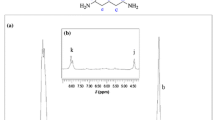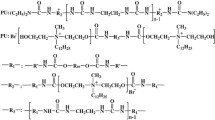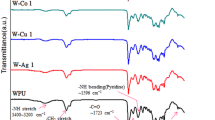Abstract
In this study, 2,6-pyridinedimethanol was used as a chain extender to synthesize a new polyurethane, PDM-PU. Further, various amounts of silver nitrate were incorporated to produce PDM-PU/AgNO3 complexes. FT-IR and UV–Vis analyses confirm the formation of complex in the PDM-PU/AgNO3. DSC and DMA results show that the glass transition temperature (T g), dynamic T g and storage modulus at 25 °C of the PDM-PU/AgNO3 complexes increase with increasing AgNO3 content. This is due to the formation of complex structure that can restrict the segmental motion of polymer chains. The TGA and stress–strain test results show that the thermal decomposition temperature, tensile strength and elongation at break increase with the AgNO3 content initially. Then, they decrease inversely. This indicates that the formation of complex structure raises these properties when the AgNO3 content is below certain value. But as more coordinate bonds were formed, the specimens become brittle. In addition, the crosslink effect caused by coordinate bonds inhibits the dissolution of polymer chains and thereby reduces the swelling degree of the complexes in solvent. Furthermore, AgNO3 imparts antibacterial activity against S. aureus and K. pneumoniae to the complexes









Similar content being viewed by others
References
Liu GQ, Guan CL, Xia HS, Guo FQ, Ding XB, Peng YX (2006) Novel shape-memory polymer based on hydrogen bonding. Macromol Rapid Commun 27:1100–1104
Tamami B, Yeganeh H, Koohmareh GA (2005) Synthesis and characterization of polyureas derived from 4-aryl-2,6-bis(4-aminophenyl) pyridines and diisocyanates. Iran Polym J 14:785–792
Chang J, Han J, An J, Im C, Yu YJ, Jin JI (2007) Photoluminescence properties of poly [2-(5′-cyano-5′-methyl-hexyloxy)-1,4-phenylene] and its copolymers with pyridine comonomer units. J Korean Phys Soc 51:1993–1998
Kato T, Mizoshita N, Kanie K (2001) Hydrogen-bonded liquid crystalline materials: supramolecular polymeric assembly and the induction of dynamic function. Macromol Rapid Commun 22:797–814
Korhonen JT, Verho T, Rannou P, Ikkala O (2010) Self-assembly and hierarchies in pyridine-containing homopolymers and block copolymers with hydrogen-bonded cholesteric side-chains. Macromolecules 43:1507–1514
Thibault RJ, Hatchkiss PJ, Rotello VM (2003) Thermally-reversible non-covalent polymer crosslinking Polym. Prepr Am Chem Soc Div Polym Chem 44(2):500
Alper J (2002) Chemists look to follow biology lead. Science 295:2396–2397
Thibault RJ, Hatchkiss PJ, Gray M, Rotello VM (2003) Thermally reversible formation of microspheres through non-covalent polymer cross-linking. J Am Chem Soc 125:11249–11252
Ihata O, Yokota H, Kanie K, Ujiie S, Kato T (2000) Induction of mesophases through the complexation between benzoic acids with lateral groups and polyamides containing a 2,6-diaminopyridine moiety. Liq Cryst. 27:69–74
Kato T, Ihata O, Ujiie S, Tokita M, Watanabe J (1998) Self-assembly of liquid-crystalline polyamide complexes through the formation of double hydrogen bonds between a 2,6-bis(amino)pyridine moiety and benzoic acids. Macromolecules 31:3551–3555
Ambrozic G, Zigon M (2005) Hydrogen-bonded liquid-crystalline polyurethane complexes with 4-dodecyloxybenzoic acid. Acta Chim Slov 52:207–214
Ihata O, Kato T (1999) Hydrogen-bonded complexes of macrocycles containing pyridyl moiety and carboxyl-functionalized polystyrenes. Polym Bull (Heidelberg) 42:497–503
Mwaura JK, Mathai MK, Chen C, Papadimitrakopoulos F (2003) Light emitting diodes prepared from terbium-immobilized polyurea chelates. J Macromol Sci Pure Appl Chem A40:1253–1262
Yu SC, Hou SJ, Chan WK (1999) Synthesis, metal complex formation, and electronic properties of a novel conjugate polymer with a tridentate 2,6-bis(benzimidazol-2-yl)pyridine ligand. Macromolecules 32:5251–5256
Meudtner RM, Hecht S (2008) Responsive backbones based on alternating triazole-pyridine/benzene copolymers: from helically folding polymers to metallo-supramolecularly crosslinked gels Macromol. Rapid Commun 29:347–351
Alaa S, Abd EA, Christian A, Nola E (2014) Sandwich complex-containing macromolecules: property tunability through versatile synthesis. Macromol Rapid Commun 35:513–559
Park IH, Chanthapally A, Zhang Z, Lee SS, Zaworotko MJ, Vittal JJ (2014) Metal–organic organopolymeric hybrid framework by reversible [2 + 2] cycloaddition reaction. Angew Chem 126:424–429
Vera F, Almuzara C, Orera I, Barbera J, Oriol L, Serrano JL (2008) Side-chain supramolecular polymers with induced supramolecular chirality through H-bonding interactions. J Polym Sci A Polym Chem 46:5528–5541
Kato T, Frechet JMJ (1995) Hydrogen bonding and the self-assembly of supramolecular liquid-crystalline materials. Macromol Symp 98:311–326
Ruokolainen J, ten Brinke G, Ikkala O, Torkkeli M, Serimaa R (1996) Mesomorphic structures in flexible polymer-surfactant systems due to hydrogen bonding: poly(4-vinylpyridine)-pentadecylphenol. Macromolecules 29:3409–3415
Valkama S, Kosonen H, Ruokolainen J, Torkkeli M, Serimaa R, ten Brinke G, Ikkala O (2004) Self-assembled polymeric solid films with temperature-induced large and reversible photonic-bandgap switching. Nat Mater 3:872–876
Valkama S, Ruotsalainen T, Nykalanen A, Laiho A, Kosonen H, ten Brinke G, Ikkala O, Ruokolainen J (2006) Self-assembled structures in diblock copolymers with hydrogen-bonded amphiphilic plasticizing compounds. Macromolecules 39:9327–9336
Tung S-H, Kalarickal NC, Mays JW, Xu T (2008) Hierarchical assemblies of block-copolymer-based supramolecules in thin films. Macromolecules 41:6453–6462
Shibata M, Kimura Y, Yaginuma D (2004) Thermal properties of novel supramolecular polymer networks based on poly(4-vinylpyridine) and disulfonic acids. Polymer 45:7571–7577
Breul AM, Schafer J, Friebe C, Schlutter F, Paulus RM, Festag G, Hager MD, Winter A, Dietzek B, Popp J, Schubert US (2012) Synthesis and characterization of poly(methylmethacrylate) backbone polymers containing side-chain pendant ruthenium(II) bis-terpyridine complexes with an elongated conjugated system. Macromol Chem Phys 213:808–819
Shen QD, Yang CZ (1998) Transition metal complexes of N-Picolyl polyurethane. J Polym Sci Part B Polym Phys 36:1539–1546
Huang SL, Chao MS, Lai JY (1998) Investigation and gas permeability of polyurethane complexes. J Appl Polym Sci 67:865–873
Francolini I, Ruggeri V, Martinelli A, D’Ilario L, Piozzi A (2006) Novel metal-polyurethane complexes with enhanced antimicrobial activity. Macromol Rapid Commun 27:233–237
Huang Y, Yu H, Xiao C (2006) Effects of Ca2+ crosslinking on structure and properties of waterborne polyurethane-carboxymethylated guar gum films. Carbohydr Polym 66:500–513
Paul D, Paul S, Roohpour N, Wilks M, Vadgama P (2013) Antimicrobial, mechanical and thermal studies of silver particle-loaded polyurethane. J Funct Biomater 4:358–375
Senthilkumar N, Raghavan A, Sultan Nasar A (2005) Novel metal-containing polyurethane elastomers prepared using tetradentate Schiff base metal complexes. Macromol Chem Phys 206:2490–2500
Tsou CH, Lee HT, Tsai HA, Cheng HJ, Suen MC (2013) Synthesis and properties of biodegradable polycaprolactone/polyurethanes by using 2,6-pyridinedimethanol as a chain extender. Polym Degrad Stab 98:643–650
Author information
Authors and Affiliations
Corresponding author
Rights and permissions
About this article
Cite this article
Lee, HT., Tsou, CH., Jou, CH. et al. The effects of silver nitrate on the structure and properties of polyurethanes containing pyridyl units. Polym. Bull. 71, 2749–2767 (2014). https://doi.org/10.1007/s00289-014-1222-2
Received:
Revised:
Accepted:
Published:
Issue Date:
DOI: https://doi.org/10.1007/s00289-014-1222-2




